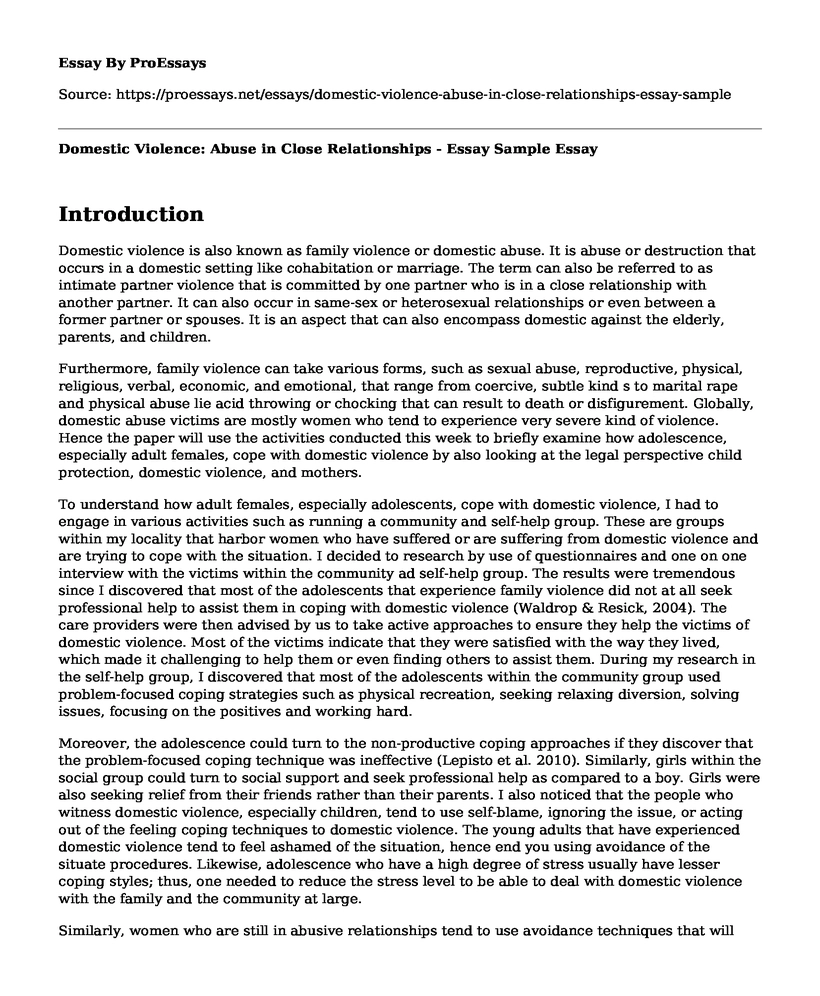Introduction
Domestic violence is also known as family violence or domestic abuse. It is abuse or destruction that occurs in a domestic setting like cohabitation or marriage. The term can also be referred to as intimate partner violence that is committed by one partner who is in a close relationship with another partner. It can also occur in same-sex or heterosexual relationships or even between a former partner or spouses. It is an aspect that can also encompass domestic against the elderly, parents, and children.
Furthermore, family violence can take various forms, such as sexual abuse, reproductive, physical, religious, verbal, economic, and emotional, that range from coercive, subtle kind s to marital rape and physical abuse lie acid throwing or chocking that can result to death or disfigurement. Globally, domestic abuse victims are mostly women who tend to experience very severe kind of violence. Hence the paper will use the activities conducted this week to briefly examine how adolescence, especially adult females, cope with domestic violence by also looking at the legal perspective child protection, domestic violence, and mothers.
To understand how adult females, especially adolescents, cope with domestic violence, I had to engage in various activities such as running a community and self-help group. These are groups within my locality that harbor women who have suffered or are suffering from domestic violence and are trying to cope with the situation. I decided to research by use of questionnaires and one on one interview with the victims within the community ad self-help group. The results were tremendous since I discovered that most of the adolescents that experience family violence did not at all seek professional help to assist them in coping with domestic violence (Waldrop & Resick, 2004). The care providers were then advised by us to take active approaches to ensure they help the victims of domestic violence. Most of the victims indicate that they were satisfied with the way they lived, which made it challenging to help them or even finding others to assist them. During my research in the self-help group, I discovered that most of the adolescents within the community group used problem-focused coping strategies such as physical recreation, seeking relaxing diversion, solving issues, focusing on the positives and working hard.
Moreover, the adolescence could turn to the non-productive coping approaches if they discover that the problem-focused coping technique was ineffective (Lepisto et al. 2010). Similarly, girls within the social group could turn to social support and seek professional help as compared to a boy. Girls were also seeking relief from their friends rather than their parents. I also noticed that the people who witness domestic violence, especially children, tend to use self-blame, ignoring the issue, or acting out of the feeling coping techniques to domestic violence. The young adults that have experienced domestic violence tend to feel ashamed of the situation, hence end you using avoidance of the situate procedures. Likewise, adolescence who have a high degree of stress usually have lesser coping styles; thus, one needed to reduce the stress level to be able to deal with domestic violence with the family and the community at large.
Similarly, women who are still in abusive relationships tend to use avoidance techniques that will help them cope with the ongoing violence. Moreover, the more frequent and severe the force is, the more possible the battered woman might take a step in leaving the relationship. Another activity that is conducted within the community or self-help group is to provide training to the battered women on problem-solving skills that assist them in reducing violence in the relationship or leaving the abusive family. Furthermore, the social group helped women in increasing join skills and social supports and also providing them with access to social services like orders of protection and legal assistance (Goodmark, 2010).
References
Goodmark, L. (2010). Mothers, domestic violence, and child protection: An American legal perspective. Violence against women, 16(5), 524-529.
Lepisto, S., AstedtKurki, P., Joronen, K., Luukkaala, T., & Paavilainen, E. (2010). Adolescents' experiences of coping with domestic violence. Journal of Advanced Nursing, 66(6), 1232-1245.
Waldrop, A. E., & Resick, P. A. (2004). Coping among adult female victims of domestic violence. Journal of family violence, 19(5), 291-302.
Cite this page
Domestic Violence: Abuse in Close Relationships - Essay Sample. (2023, Apr 10). Retrieved from https://proessays.net/essays/domestic-violence-abuse-in-close-relationships-essay-sample
If you are the original author of this essay and no longer wish to have it published on the ProEssays website, please click below to request its removal:
- Research Paper on Los Angeles County's Criminal Street Gangs
- Ethical Issues in Treating Childhood Obesity Paper Example
- Impacts of Racism Essay Example
- Essay Sample on The Role of Women in the 1950s
- Curbing Drug Use at Hazelwood Central High: A Staff Development Program - Research Paper
- Family Violence: Unacceptable Conduct Between Intimate Relationships - Essay Sample
- Free Paper on Tobacco Abuse: A Growing Global Threat to Human Health







